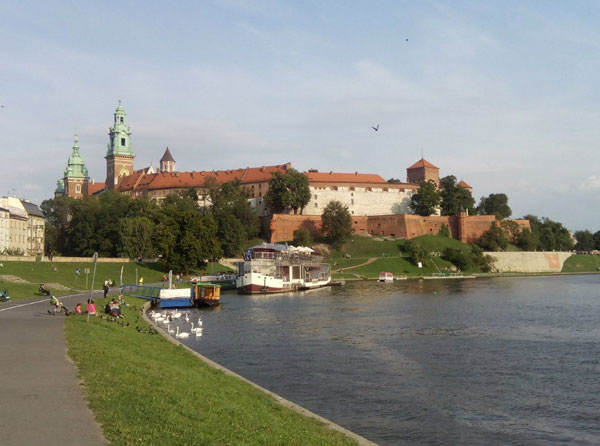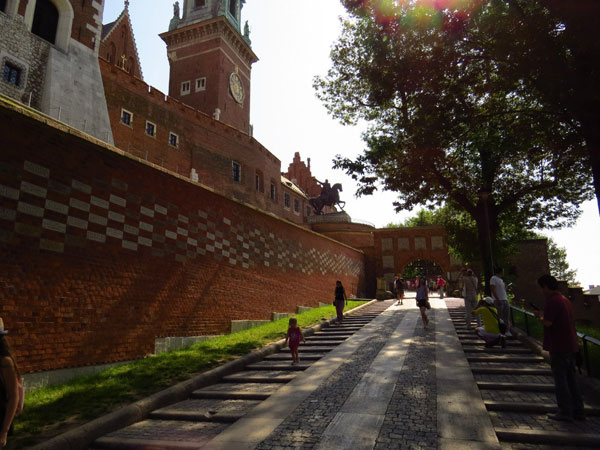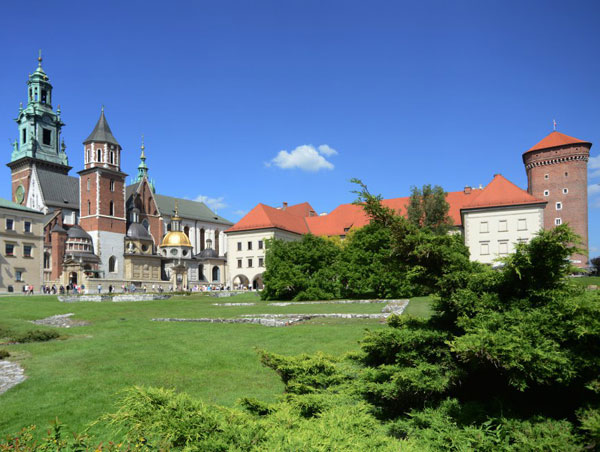Wawel (Polish pronunciation: [ˈvavɛl]) is a fortified architectural complex erected over many centuries atop a limestone outcrop on the left bank of the Vistula river in Kraków, Poland, at an altitude of 228 metres above sea level.[1][2]
The complex consists of many buildings and fortifications; the largest and best known of these are the Royal Castle and the Wawel Cathedral (which is the Basilica of St Stanisław and St Wacław). Some of Wawel's oldest stone buildings, such as the Rotunda of the Virgin Mary can be dated to 970AD. There are also wooden parts of the complex which date to about the 9th century.[3] The castle itself has been described as "one of the most fascinating of all European castles." [4]
Wawel is a place of great significance to the Polish people: it first became a political power centre at the end of the first millennium AD and in the 9th century, the principal fortified castrum of the Vistulans tribe (Polish: Wiślanie). The first historical ruler Mieszko I of Poland (c.965–992) of the Piast dynasty and his successors: Boleslaw I the Brave (Polish: Bolesław I Chrobry; 992–1025) and Mieszko II (1025–1034) chose Wawel to be one of their residences. At the same time Wawel became one of the principal Polish centres of Christianity. The first early Romanesque buildings were erected there including a stone cathedral serving the bishopric of Kraków in the year 1000. From the reign of Casimir the Restorer (1034–1058) Wawel became the leading political and administrative centre for the Polish State.[1]
Until 1611, the Wawel was the formal seat of the Polish monarchy; this was because Kraków was the capital of Poland from 1038 to 1569 and of the Polish–Lithuanian Commonwealth from 1569 to 1596.[5] Later, it became the Free City of Kraków from 1815 to 1846; the Grand Duchy of Cracow from 1846 to 1918; and Kraków Voivodeship from the 14th century to 1999. It is now the capital of the Lesser Poland Voivodeship. Therefore, the fortress-like Wawel complex which visually dominates the city has often been viewed as seat of power. Wawel Cathedral was not only a place of coronation for the Kings of Poland, but also their mausoleum. Later, it became a national pantheon.
During the 20th century, the Wawel was the residence of the President of Poland; after the invasion of Poland at the start of World War II, Kraków became the seat of Germany's General Government, and the Wawel subsequently became the residence of the Nazi Governor General Hans Frank. Following the cessation of hostilities, the Wawel was restored and once again become a national museum, a place of worship and centre depicting Poland's complex history.












